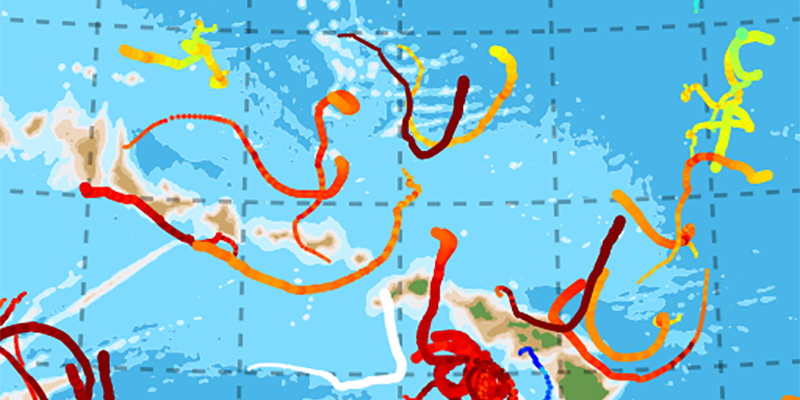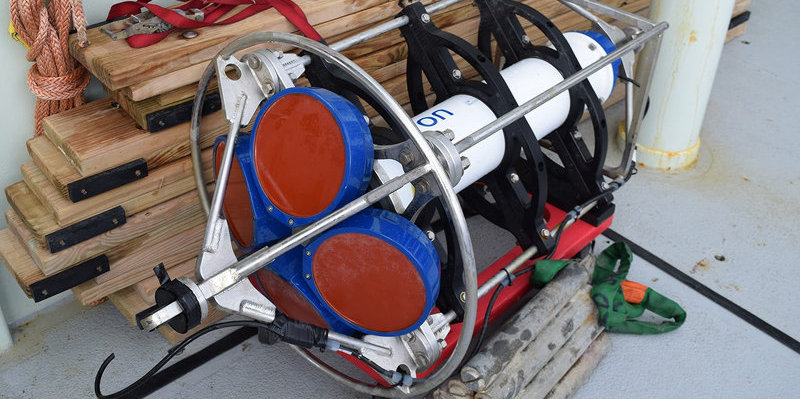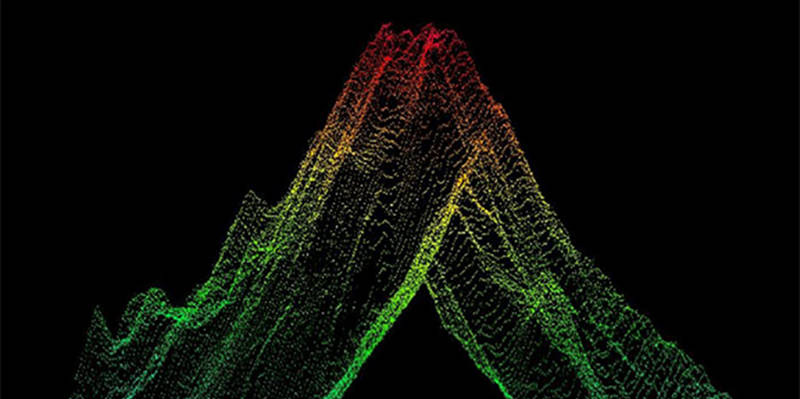Acoustic Doppler Current Profiler
An acoustic Doppler current profiler, or ADCP, is a device that uses sound waves to measure the speed and direction of currents throughout the water column. Understanding how water in the ocean moves provides important information about biological, chemical, and physical properties of the ocean.
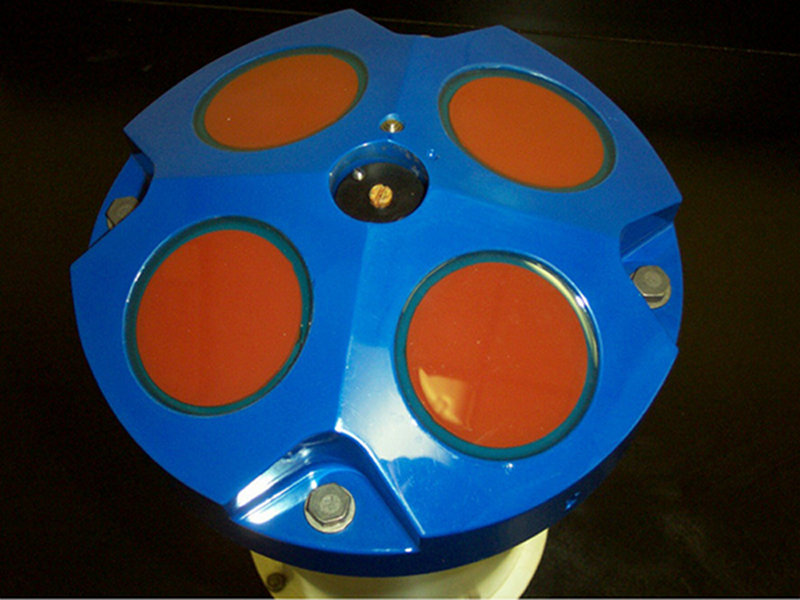
Typical 4 beam ADCP sensor head. The red circles denote the 4 transducer faces. Image courtesy of NOAA. Download image (jpg, 98 KB).
How Does It Work?
The ADCP uses the Doppler effect by transmitting “pings” of sound using a sequence of consistent rapid pulses that ricochet off particles suspended in moving water and reflect back to the instrument. Particles moving toward the instrument return waves with a higher frequency (or pitch), while particles moving away produce a lower-frequency return. Since the particles move at the same speed as the water that carries them, the difference in frequency between the sound waves the profiler sends out and the sound waves it receives can be used to calculate how fast the particle and the water around it are moving. The system tracks when each of the pings is returned; as pings that travel further (lower) will return later, this translates to current data across a variety of depths.
ADCPs use a series of acoustic transducers that emit and receive pings from different directions. The instrument can be mounted directly on a stationary object like a mooring buoy or even directly on the seafloor. They can also be mounted to a moving vehicle, such as ships or unmanned underwater and surface vehicles. On large research vessels, the ADCP is permanently mounted on the bottom of the ship’s outer hull.
As with other types of sonars, ADCPs are available in different frequencies. Higher frequencies, for example 300 kiloHertz (kHz), are useful in providing high-resolution data near the surface to a depth range of around 70 meters (230 feet). Lower frequency ADCPs, such as 38 kHz, will provide lower-resolution data to a depth range of up to 1,300 meters (4,265 feet), depending on surrounding noise levels in the ocean.
What Happens Next?
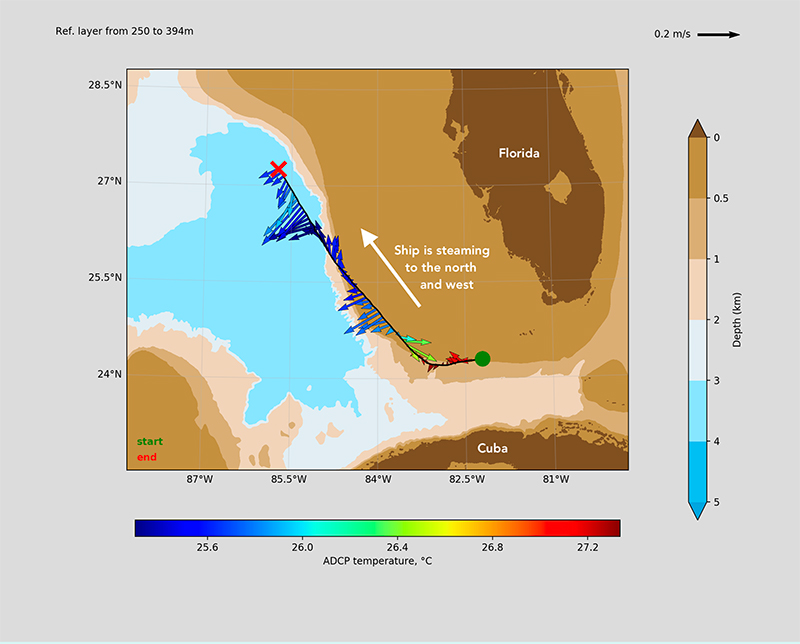
Example of an ADCP vector plot. The black line is the ship’s track, while it measured ocean currents with the ADCP. The red "X" is the location of the most recent data. The many arrows coming from the cruise track show the magnitude and direction of currents averaged over a vertical layer, in this case about 250 to 400 meters (820 to 1,310 feet). The vectors are colored by the temperature at the transducer face, since that is the only temperature measurement an ADCP makes. Image courtesy of the NOAA Office of Ocean Exploration and Research, Discovering the Deep: Exploring Remote Pacific MPAs. Download larger version (jpg, 593 KB).
Trigonometric relationships are used to convert the return signal received from an ADCP’s transducers to ‘Earth’ coordinates (north-south, east-west, and up-down). Because the emitted sound extends from the transducer down through the water column, the ADCP measures the current at many different depths simultaneously. This way, it is possible to determine the speed and direction of the various currents that exist from the surface of the ocean to the bottom (or the depth range of the instrument). Plotting calculated speed and direction by depth results in what is known as a water current profile.
During operation, the ADCP is sending out and receiving an acoustic pulse every few seconds. Higher-frequency instruments are set to ping more frequently than low-frequency instruments, because their range is smaller, so the sound doesn’t travel as far. On shipboard systems, the return signal is sent to a computer where it can be manipulated using specialized software. Care must be taken with shipboard systems to account for heading changes and remove the motion of the ship, before deducing the ocean currents. A real-time display of the magnitude and direction of the current throughout the water column can be produced, allowing scientists to observe the changing ocean current structure nearly continuously while the ship is in motion.
On NOAA Ship Okeanos Explorer, automated ADCP data collection and processing are done by University of Hawaii’s UHDAS system. The UHDAS Team monitors the health of the ADCP systems on NOAA and academic research fleets.
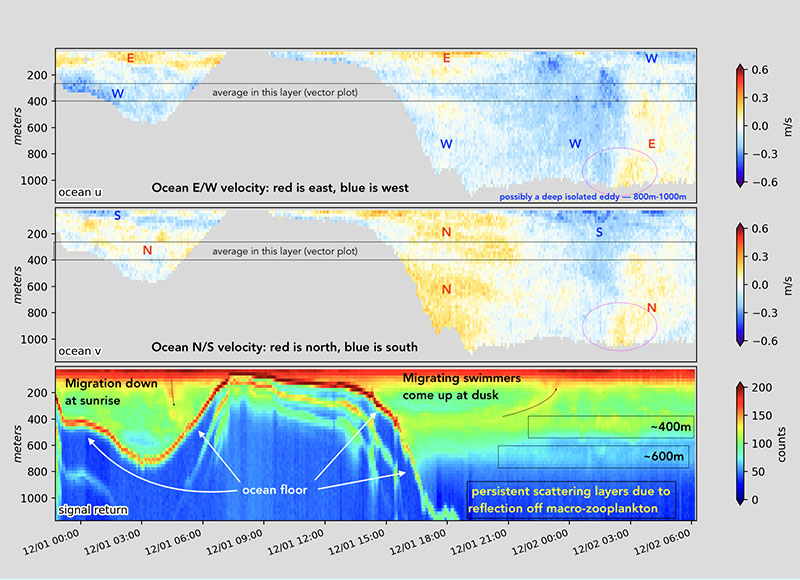
Example of an ADCP velocities with depth. This color panel plot shows three panels with horizontal velocities in the East-West (E/W) direction (top panel), North-South (N/S) direction (second panel) and signal return (bottom panel). Time increases from left to right as the ship transits to the northwest (same data as the vector plot, above). The vertical axis is depth in meters.
Three interesting features are (1) in the first 12 hours of the data, the surface flow (upper 100 meters/328 feet) is going in the opposite direction to the water below it; (2) a sharp transition from southwestward flow to northeastward flow at about 12/02 02:00 in the water below 200 meters (656 feet) is not visible at the surface at all; and (3) the third panel shows the bright red reflection of the ocean bottom, but also shows persistent scattering layers at about 400 meters (1,312 feet) and 600 meters (1,967 feet), and the diurnal migration of zooplankton. Image courtesy of the NOAA Office of Ocean Exploration and Research. Download larger version (jpg, 805 KB).
Why Is It Important?
Measuring currents is a fundamental practice of physical oceanographers. By determining how ocean water moves, scientists can determine how organisms, nutrients, and other biological and chemical constituents are transported throughout the ocean. Because of its high resolution and ability to gather data deep within the ocean interior, the ADCP is an efficient tool for sampling a large section of the ocean in a limited amount of time.
Ocean waters have varied temperatures and in places like the warm Gulf Stream, the movement of water means the movement of heat. Heat transport in the ocean is a critical component of the global heat budget and thus plays an important role in Earth’s global climate. Nutrient transport is important for biological studies such as biomass concentrations, and sediment transport is important for geological studies such as river and beach changes over time. ADCPs can only measure temperature at the transducer (so at the transducer face, on the ship’s hull), but when used in conjunction with other measurements, the combination of temperature and currents is a powerful tool for study.
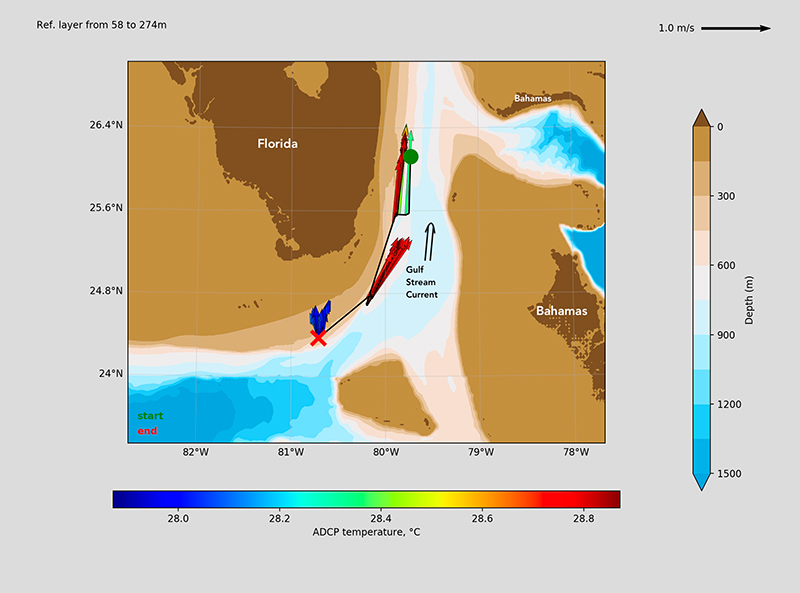
This figure shows the surface current direction and magnitude from 60 meters-275 meters (200-900 feet) during three ROV dives on the 2019 Southeastern U.S. Deep-sea Exploration on NOAA Ship Okeanos Explorer. The currents in the Gulf Stream are very strong, and the ROV pilots need to know what they are dealing with when they send the vehicle down. Image courtesy of NOAA Office of Ocean Exploration and Research. Download larger version (jpg, 581 KB).
On a smaller scale, ADCPs are useful for helping to characterize the physical oceanography of a specific area and assessing currents near remotely operated vehicle (ROV) dive locations. Data collected from an ADCP can be used to inform dive planning and ensure safe ROV deployment and recovery operations.
